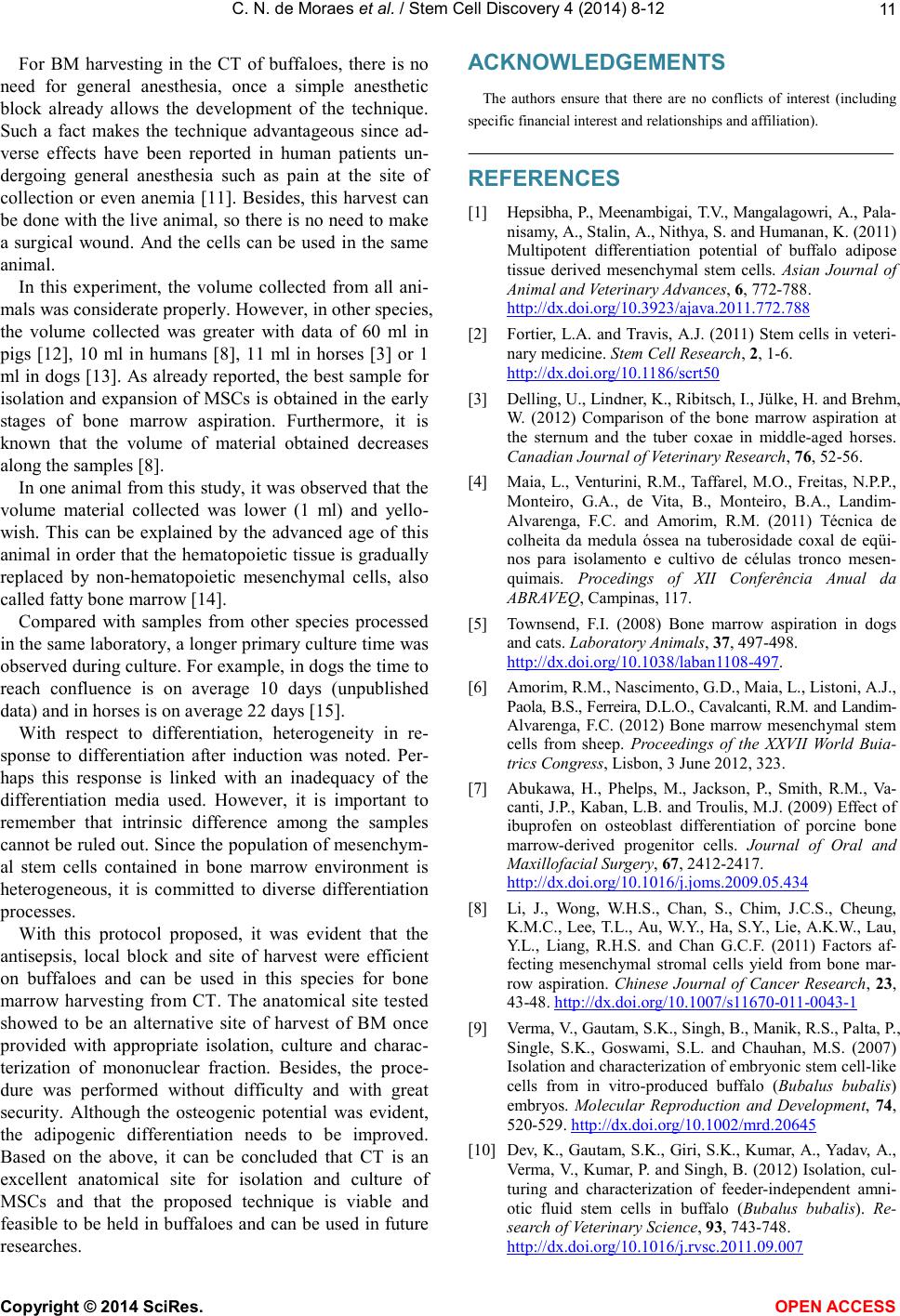
C. N. de Moraes et al. / Stem Cell Discov ery 4 (2014) 8-12
Copyright © 2014 SciRe s . OPEN ACCESS
For BM harvesting in the CT of buffaloes, there is no
need for general anesthesia, once a simple anesthetic
block already allows the development of the technique.
Such a fact makes the technique advantageous since ad-
verse effects have been reported in human patients un-
dergoing general anesthesia such as pain at the site of
collection or even anemia [11]. Besides, this harve st can
be done with the live a ni mal, so there is no need to make
a surgical wo u n d . And the cells can be used in the same
animal.
In this experiment, the volume collected from all ani-
mals was considerate properly. However, in other species,
the volume collected was greater with data of 60 ml in
pigs [12], 10 ml in humans [8], 11 ml in horses [3] or 1
ml in do gs [13]. As already reported, the best sample for
isola tion and e xpansio n of MSCs i s obtai ned in the ea rly
stages of bone marrow aspiration. Furthermore, it is
known that the volume of material obtained decreases
along the samp les [8].
In one ani mal fro m t his s tud y, i t wa s ob serve d t hat the
volume material collected was lower (1 ml) and yello-
wish. This can be explained by the advanced age of this
animal in or der that the he matopoie tic tissue is graduall y
replaced by non-hematopoietic mesenchymal cells, also
called fatty bone marrow [14].
Compared with samples from other species processed
in the same laboratory, a longer primary culture time was
obs er ved d ur ing cultur e. Fo r exa mpl e, i n d o gs the ti me to
reach confluence is on average 10 days (unpublished
data) and in horses is on average 22 days [15].
With respect to differentiation, heterogeneity in re-
sponse to differentiation after induction was noted. Per-
haps this response is linked with an inadequacy of the
differentiation media used. However, it is important to
remember that intrinsic difference among the samples
canno t be ruled out. Since the population of mesenchym-
al stem cells contained in bone marrow environment is
heter o geneo us , it is committed to diverse differentiation
pro ce sses.
With this protocol proposed, it was evident that the
antisepsis, local block and site of harvest were efficient
on buffaloes and can be used in this species for bone
marrow harvesting from CT. The anatomical site tested
showed to be an alternative site of harvest of BM once
provided with appropriate isolation, culture and charac-
terization of mononuclear fraction. Besides, the proce-
dure was performed without difficulty and with great
security. Although the osteogenic potential was evident,
the adipogenic differentiation needs to be improved.
Based on the above, it can be concluded that CT is an
excellent anatomical site for isolation and culture of
MSCs and that the proposed technique is viable and
feasible to be held in buffaloe s and can b e used in futur e
researches.
ACKNO WLE DGE MENTS
The authors ensure that there are no conflicts of interest (including
specif i c fi nanc ial in terest and re l ation s hi ps an d aff il iatio n) .
REFERENCE S
[1] Hepsibha, P., Meenambigai , T.V., Mangalago wri, A., Pala-
nisamy, A., Stalin, A., Nithya, S. and Humanan, K. (2011)
Multipotent differentiation potential of buffalo adipose
tissue derived mesenchymal stem cells. Asian Journal of
Animal and Ve ter inary Adva nc es , 6, 772-788.
http://dx.doi.org/10.3923/ajava.2011.772.788
[2] Fortier, L.A. and Travis, A.J. (2011) St em cells in v eteri-
nary medicin e. Stem Cell Research, 2, 1-6.
http://dx.doi.org/10.1186/scrt50
[3] Delling, U., Lindner, K., Ribitsch, I., Jülke, H. and Brehm,
W. ( 2012) Comparison of the bone marrow aspiration at
the sternum and the tuber coxae in middle-aged horses.
Canadian Jour n al of Veterinary R esearch, 76, 52-56 .
[4] Maia, L., Venturini, R.M., Taffarel, M.O., Freitas, N.P.P.,
Monteiro, G.A., de Vita, B., Monteiro, B.A., Landim-
Alvarenga, F.C. and Amorim, R.M. (2011) Técnica de
colheita da medula óssea na tuberosidade coxal de eqüi-
nos para isolamento e cultivo de células tronco mesen-
quimais. Procedings of XII Conferência Anual da
ABRAVEQ, Campinas , 117.
[5] Townsend, F.I. (2008) Bone marrow aspiration in dogs
and cat s. Labor atory A n i m als , 37, 497-498.
http://dx.doi.org/10.1038/laban1108-497.
[6] Amorim, R.M., Nascimento, G.D., Maia, L., Listoni, A.J.,
Paola, B.S., Ferreira, D.L.O., Cavalcanti, R.M. and Landim-
Alvarenga, F.C. (2012) Bone marrow mesenchymal stem
cells from sheep. Proceedings of the XXVII World Buia-
trics Congress, Lisbon, 3 J une 2012, 323.
[7] Abukawa, H., Phelps, M., Jackson, P., Smith, R.M., Va-
canti, J.P., Kaban, L.B. and Troulis, M.J. (2009) Effect of
ibuprofen on osteoblast differentiation of porcine bone
marrow-derived progenitor cells. Journal of Oral and
Maxi ll ofac ial Surgery, 67, 2 412-2417.
http://dx.doi.org/10.1016/j.joms.2009.05.434
[8] Li, J., Wong, W.H.S., Chan, S., Chim, J.C.S., Cheung,
K.M.C., Lee, T.L., Au, W.Y., Ha, S.Y., Lie, A.K.W., Lau,
Y.L., Liang, R.H.S. and Chan G.C.F. (2011) Factors af-
fecting mesenchymal stromal cells yield from bone mar-
row aspiration. Chinese Journal of Cancer Research, 23,
43-48. http://dx.doi.org/10.1007/s11670-011-0043-1
[9] Verma, V., Gautam, S.K., Singh, B., Manik, R.S., Palta, P.,
Single, S.K., Goswami, S.L. and Chauhan, M.S. (2007)
Isolat ion and characterizat ion of embryonic stem cell-like
cells from in vitro-produced buffalo (Bubalus bubalis)
embryos. Molecular Reproduction and Development, 74 ,
520-529. http://dx.doi.org/10.1002/mrd.20645
[10] Dev, K., Gautam, S.K., Giri, S.K., Kumar, A., Yadav, A.,
Verma, V., Kumar, P. and Singh, B. (2012) Isolation, cul-
turing and characterization of feeder-independent amni-
otic fluid stem cells in buffalo (Bubalus bubalis). Re-
search of Veterinary Science, 93, 743-748.
http://dx.doi.org/10.1016/j.rvsc.2011.09.007